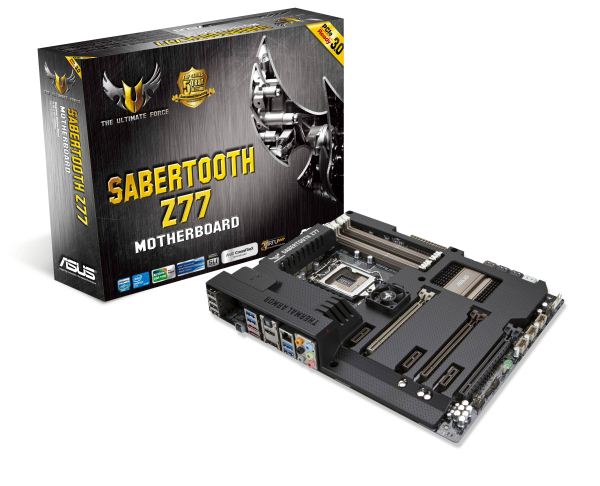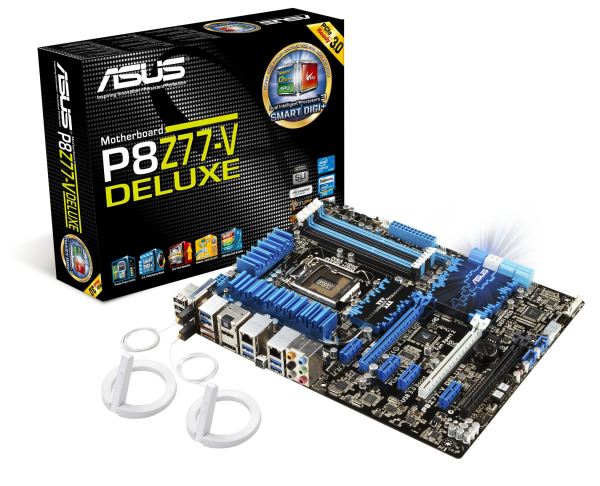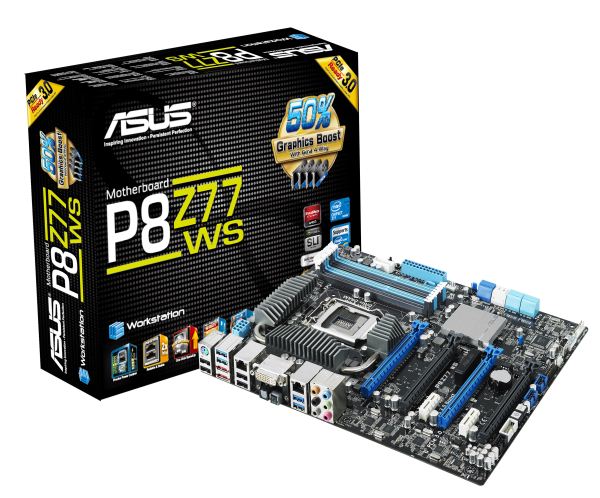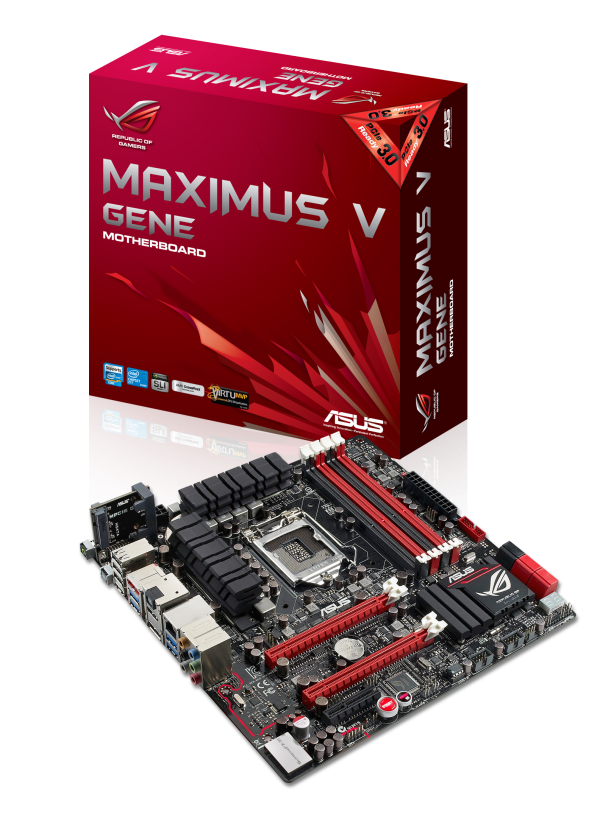A Brief Look at Some Upcoming 7-Series Motherboards
by Ian Cutress on March 9, 2012 5:00 PM EST- Posted in
- Motherboards
- Intel
- H77
- Z77
ASUS
The big motherboard vendors will have at release their usual gamut of motherboards to fit a variety of price points, and ASUS is no exception. The usual lineup from ASUS should consist of several channel board models (LE, -V, Pro, Deluxe, WS, Sabertooth), to then be followed by a variety of Republic of Gamers motherboards (Gene, Maximus, Formula) over the next few months. Today we have images detailing several of these products.
ASUS Sabertooth Z77
The Sabertooth Z77 is part of ASUS’ range of TUF motherboards, supporting an unparalleled level of motherboard cooling control all wrapped up in a five-year warranty. I have been lucky enough to see this board in action, and there are some fun new features to get to grips with: Fan Xpert 2 allows complete fan control, with onboard optimization of fan levels. There is even a feature that allows the fans to keep spinning for a short while after the PC is turned off to remove that stagnant warm air from components.
ASUS P8Z77-V Deluxe
The P8Z77-V Deluxe represents the top end of the ASUS channel board range, and immediately we can see that ASUS is now starting to put on-board Wifi onto these boards. I had a good chat with one of ASUS’ PR, and in their view if at least 25% of their users require a feature, it will be added. Well it turns out that at least a quarter of people according to ASUS use a wireless connection for their PC to get to the internet, and as such this feature should be added across the range. In my eyes, this is a welcome addition which can only add value. The Deluxe also sports Intel network controllers, a feature that works its way down to the other channel boards.
ASUS P8Z77 WS
The WS (workstation) motherboard from ASUS is becoming a staple of their range. This Z77 model, aside from featuring DVI output (rather than HDMI/DisplayPort which the models above do) and dual Intel network controllers, contains a special PCIe 3.0 PLX chip to increase the number of PCIe 3.0 lanes on the motherboard. This gives the PCIe layout to reach x8/x8/x8/x8 all in 3.0 mode, which becomes useful for multi-GPU simulators in increasing GPU-to-GPU throughput. It will be interesting to see if this PLX chip has any performance decrease associated with it like the NF200 did. This WS board supports Intel’s 3rd Generation Intel Core Xeon processors and ECC memory to fit into the workstation category, albeit with more overclock options than a standard workstation board.
ASUS ROG Maximus V Gene
The Gene range of ASUS’ Republic of Gamers boards caters to the crowd wanting small yet powerful systems, with all the functionality of the main size boards (albeit missing a few PCIe ports). The Maximus V Gene doesn’t fail to disappoint – as it has the ROG treatment, we still get access to the ROG forums with dedicated ASUS employees to help optimize any configuration. The port on the IO panel is of interest – this is what ASUS calls an ‘augmentation port’, which provides space for both a mini-PCIe slot and an mSATA port. This would allow users to supply their own wifi module and mini-SSD as required, without taking up valuable space around the rest of the board. Other ROG features include PCB isolation for the audio to reduce electromagnetic interference, and ROG exchange – the ability for users to share overclocking results for similar systems and setups and see exactly all the settings required to make those overclocks.














55 Comments
View All Comments
fatpenguin - Friday, March 9, 2012 - link
I was very excited to find that Ivy Bridge is supposed to support up to 3 Display Port outputs natively, since it would eliminate any need for an external graphics card (for me personally). Have you seen any vendors offer this on any current 7-series motherboards?IlllI - Friday, March 9, 2012 - link
you guys should do some review with m-itx motherboards.Knifeshade - Friday, March 9, 2012 - link
I think this is one of the most interesting boards to come out of CeBIT '12. For people who don't need so much expansion slots, they're moving to smaller platforms and this mini ITX board really feels like it's got everything its older siblings have but in a much smaller package. I hope you guys can get one in to have a look over.James5mith - Friday, March 9, 2012 - link
Why aren't more companies putting out products with displayport? It's a great interface, and both Dell and HP have adapted to it wholeheartedly. I personally can't wait until the industry gives up VGA and DVi in favor of it.lbeyak - Saturday, March 10, 2012 - link
High end Z77 boards. I like the look of most of the Asus boards (especially the Sabertooth, 5 year warranty /drools).Reviews on boards with dual NICs would be nice as well.
Integrated Wi-Fi / Bluetooth is interesting to me as well, and I like that they are included on some boards.
Jumpman23 - Saturday, March 10, 2012 - link
Why can't all the usb ports be of the 3.0 flavor? Is it a cost issue? I would assume that usb ports are a fairly small portion of the overall cost for these manufacturers so why not make them all 3.0?IanCutress - Saturday, March 10, 2012 - link
Primarily, it is cost - Z77 gets a couple of USB 3.0 from the chipset, then the rest is controllers. Each controller comes at a cost (I don't know how much, but with markup, probably $5 a piece perhaps[?]), which then gets passed on.Personally, I like to have two or three USB 2.0. When I install an OS for a review, it's via a USB stick - the install package doesn't have a USB 3.0 driver installed, so it can't detect itself when it is loaded (or won't detect my mouse or keyboard). Odd I know, but it means I have to dig out an OS disk if a board goes for solely USB 3.0.
repoman27 - Sunday, March 11, 2012 - link
There are plenty of USB devices (most of the ones in currently in existence, actually) that will never benefit from USB 3.0's additional capabilities. While I agree that it would be simpler for the end user if all the ports were the same, the 7-series chipsets provide 4x USB 3.0 ports and 10x USB 2.0. Since you get the 2.0 ports for free, why not use them?I actually believe it's more of a bandwidth problem than a straight cost issue for Ivy Bridge. (I was under the impression that the Renesas μPD720201 4-port controllers only run about $3 these days.) However, if you were to make all 6 of the SATA ports 6 Gbps and all 14 of the USB ports SuperSpeed on a 7-series motherboard, you'd be adding an additional ~26 Gbps of potential I/O to a southbridge that's only got a 20 Gbps DMI connecting it to the CPU.
Dr. Mobius - Saturday, March 10, 2012 - link
I would really like to see EVGA's line up.Breach1337 - Saturday, March 10, 2012 - link
Great, I personally would love to get the Asus Z77 Sabertooth, but I'm still confused by these PCIe specs? AFAIK, IB has only 16 PCI-E lanes (although they are 3.0 lanes). So if the boards say:2 x PCIe 3.0/2.0 x16 (x16 or dual x8) *2
1 x PCIe 2.0 x16 (x4 mode, black) *3
3 x PCIe 2.0 x1
And I have two PCIe 3.0 cards running x8 SLI where would the extra lanes come for the rest of the stuff - all these PCIe 2.0 slots? Say, if I plug in a 3rd card - my Creative PCI-e 2.0 x1 card would that hurt the 2 x8 SLI's performance?